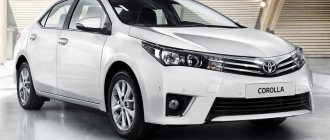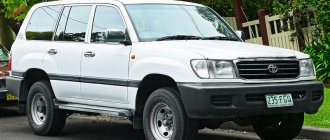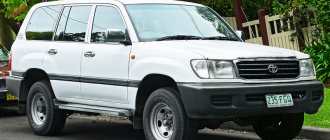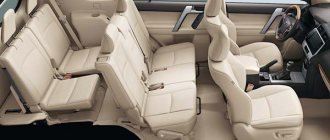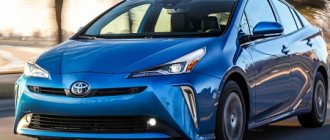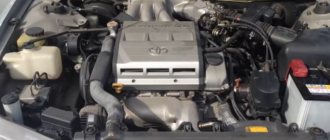A versatile and practical car produced by a Japanese brand is very popular in many countries. Since the start of mass production of the right-hand drive crossover in early 2003, it has been highly appreciated by buyers all over the world. An excellent combination of functionality, technical excellence and a magnificent exterior in a sporty style - the dream of the most demanding car enthusiasts.
General characteristics and design of Toyota Wish
The compact size car has 5 doors and 3 rows of seats and comfortably accommodates 7 people. The minivan class crossover is made taking into account the current fashion trends of the modern car market. Toyota Vish is developed based on Corolla. Since there are no official supplies of the Japanese crossover in Russia, in our country it is presented in a right-hand drive version.
This beautiful sports crossover has a carefully thought-out and harmonious design. It is impossible to take your eyes off the smooth lines brought together into a monolithic elongated shape. The wedge-shaped front end seems to cut through the air when driving fast. The side windows extend towards the trunk, giving passengers an excellent view.
The wide wheel arrangement and comfortable floor create sufficient space in the cabin for passengers. This does not reduce the size of the trunk at all. The main difference between this model and the more familiar ones with 2 rows is the increased interior comfort and spacious luggage compartment.
Toyota Wish was the result of the manufacturer's pursuit of ideality. The steering wheel is multifunctional. The stylish interior is made in dark shades, and high-quality materials that are pleasant to the touch are used for upholstery. The interior is equipped with various accessories for maximum passenger comfort - pockets, holders, drawers under the seats.
Toyota Wish - a luxury car for the money
I owned the car for about 5 years. I sold it out of a desire to buy something more representative. In general, Vish suited me completely. The first six months the impression of the car was more emotional. Although the car was old (2005, I bought it in 2015, sold it in 2021), it worked no worse than new ones.
From the moment of purchase I started keeping a maintenance cost diary. Without taking into account gasoline and insurance, the car cost no more than 17 thousand rubles per year. There were no major breakdowns. Mainly fluids, filters, consumables and running gear.
In my review of the Toyota Vish, I would like to note the ease of carrying out routine maintenance:
- manuals and guides can be Googled in 5 minutes;
- The work can be done independently with minimal skills and spare parts.
The ideal option for a car is a measured ride at 100-120 km/h. The Schumachers had better not covet this model. Disappointment is guaranteed. Fuel consumption is acceptable. I had an automatic transmission in Visha, and in the combined cycle it took 8-8.5 liters of 92-grade gasoline.
The advantage of the model is adaptation to long runs. The model is ideal for intercity travel. During the entire period of ownership, my back never got stiff, nothing got tired or hurt. You really relax behind the wheel. And my head doesn’t hurt, thinking about where to change what and what spare parts to buy. The car is reliable if you approach it carefully and do everything on time.
Technical and operational characteristics
Toyota Vish has a powerful and reliable engine of 1.8 and 2 liters with 4 rows of cylinders, and is also equipped with a variable gas distribution phase system.
Power of the main versions of the crossover:
- with all-wheel drive - 125 hp;
- with front-wheel drive - 132 hp;
- the latest version of the car equipped with a variator is 155 hp.
The package includes a four-speed automatic transmission. The modern D4 power system is highly efficient and reliable. The front suspension of the Toyota Vish is represented by a shock-absorbing strut. The stand is equipped with a screw type spring. The rear suspension is 2-link. But front-wheel drive versions of the crossover provide a simplified rear suspension (torsion bar type).
The car maneuvers superbly, and the engine is almost silent. Different versions of this model have a different turning radius. A minivan with front-wheel drive has a radius of 5.3 m, 4 WD - 5.5 m. All-wheel drive Toyota Vish with a 1.8 liter engine provides for connecting the rear axle using an electro-mechanical clutch.
Review of Toyota Vish: that same Japanese
As a native resident of Vladivostok, I only consider Japanese cars. Domestic “basins” somehow do not seduce. I looked for a car for a long time and eventually settled on Visha. I have only positive feedback about Toyota.
I bought the car in Japan in 2021. At that time she was 7 years old. The total mileage reached 90 thousand km. In almost 4 years of operation on Russian roads, I added another 100 thousand km. The indicators are decent. However, the car as a whole works like a clock. There were literally no problems at all.
After the purchase, I had to tinker with it, since the previous owner of the car had undervalued it. Driving around Vladik like this is not an option at all.
A positive review of Toyota Vish was formed thanks to:
- Completely Japanese assembly (this car is only made in Japan).
- No serious breakdowns (I change consumables, but this is a minor thing).
- Excellent spaciousness.
- Interior ergonomics.
- Convenience for drivers and passengers.
Toyota Wish protection systems
Crossover protective systems:
- anti-lock braking system, characterized by uniform distribution of brake forces;
- additional Brake Assist brake system;
- airbags - 2 as standard (additional installation of side airbags is possible);
- curtain airbags (purchased separately).
Even basic models are equipped with these systems. The most expensive versions of this model are equipped with especially powerful headlights that perfectly illuminate the road in the dark. The expensive package also includes an aero body kit, and the steering wheel is covered with leather wicker.
Table of technical characteristics of Toyota Wish engines
Depending on the generation and restyling, Toyota Wish was equipped with gasoline engines of various sizes: 1ZZ-FE, 1AZ-FSE, 2ZR-FAE and 3ZR-FAE. These motors have proven themselves to be reliable and high-quality units with a long service life. The maintainability of such internal combustion engines is within average costs.
| Engine make | 1ZZ-FE | 1AZ-FSE | 2ZR-FAE | 3ZR-FAE |
| Motor type | 16 valve (DOHC – 2 camshafts) | 16 valve (DOHC – 2 camshafts) | 16-valve Valvematic (DOHC – 2 camshafts) | 16-valve Valvematic (DOHC – 2 camshafts) |
| Working volume | 1794 cm 3 | 1998 cm 3 | 1797 cm 3 | 1986 cm 3 |
| Cylinder diameter | From 79 to 86 mm. | 86 mm. | 80.5 mm. | 80.5 mm. |
| Compression ratio | From 9.8 to 10 | From 10 to 11 | 10.7 | 10.5 |
| Piston stroke | From 86 to 92 mm. | 86 mm. | From 78.5 to 88.3 mm. | 97.6 mm. |
| Maximum torque at 4000 rpm. | 171 N*m | 200 N*m | 180 N*m | 198 N*m |
| Maximum power at 6000 rpm. | 136 hp | 155 hp | 140 hp at 6100 rpm. | 158 hp |
| CO 2 release | From 171 to 200 g/km | From 191 to 224 g/km | From 140 to 210 g/km | From 145 to 226 g/km |
| Fuel consumption | From 4.2 to 9.9 liters per 100 km. | From 5.6 to 10.6 liters per 100 km. | From 5.6 to 7.4 liters per 100 km. | From 6.9 to 8.1 liters per 100 km. |
As can be seen from the table, Toyota Wish engines have undergone minor changes throughout the entire production period, for example, differences in displacement (1AZ-FSE and 3ZR-FAE compared to 1ZZ-FE and 2ZR-FAE). Otherwise, speed and power indicators remained without major changes.
Major changes
The manufacturer is constantly working to improve this popular car. The main changes affected the front bumper and rear. Powerful reflectors began to be built into the rear bumper.
The body is now equipped with shiny chrome-plated elements. This adds more appeal to an already chic model. The latest design changes took place in 2005. They affected headlights and bumpers, as well as interior equipment (control panel). The production of Toyota Wish continues in this version.
Description of the Toyota Wish model
The Toyota Wish began production on January 20, 2003, but was first introduced in 2002. As stated by chief design engineer Takeshi Yoshida, Wish became a continuation of the earlier version of the Toyota Corolla, the main working components were taken from it.
Wish went on sale gradually in many countries, starting from Japan and further: Taiwan, Thailand, etc. In different countries, the car's equipment changed, for example, in Thailand the car did not receive tinted windows, but the general suspension design remained. For Taiwan, the manufacturer radically revised some body elements: taillights, bumper, and the car also received several new chrome-plated parts.
Toyota Wish
Production of the first generation ceased in 2005, and a few months later the Toyota Wish model reappeared on the market, but only after restyling. There were no special design changes; the equipment and some body parts changed slightly. The production of the first generation restyling continued until 2009.
The second generation of the “minivan” was released in an updated body with upgraded engines of various sizes and power (2ZR-FAE and 3ZR-FAE), as well as front-wheel drive and all-wheel drive. The Wish received larger dimensions, but inside it remained a spacious and comfortable car, perfectly suitable for the family car category.
The second generation restyling appeared on the market in 2012. The “Minivan” was changed not only outside, but also inside.
Technologies of that time made it possible to achieve greater efficiency and reduce fuel consumption. The manufacturer's bias was made towards safety, and the car received ABS systems with EBD and Brake Assist. And also several pleasant and convenient bonuses: parking sensors and stability control.
1ZZ-FE – first generation engine
The first generation Toyota Wish was dominated by the 1ZZ-FE unit, which was also installed on Pontiac Vibe, Toyota Allion and Toyota Caldina, etc. There is no need to list all the models in full, since this motor is very popular and has earned a positive rating for its trouble-free operation, reliability and low costs in terms of maintainability.
Engine Toyota Wish 1ZZ-FE
The main problem with this unit was noticed during its production from 2005 to 2008. The malfunction was not in the unit itself, but in its control module, which is why the engine could suddenly stall, but random gear changes were also noticed. The 1ZZ-FE defect led to the withdrawal of two car models from the market: Toyota Corolla and Pontiac Vibe.
The motor housing is made of high-quality aluminum, which is practically impossible to solder, for example, if the crankcase is defrosted. The use of aluminum made it possible to reduce the weight of the internal combustion engine, while the power characteristics remained at a high level.
The advantage of 1ZZ-FE is that during a major overhaul there is no need to bore the cylinders, since the unit is equipped with cast iron liners and you just need to replace them.
Popular 1ZZ-FE faults:
- Increased oil consumption, which awaits all 1ZZ-FE models released before 2005. Oil scraper rings that are not wear-resistant enough begin to leak oil after 150,000 km, and therefore require replacement. After replacing the worn-out rings, the problem disappears.
- The appearance of a rustling noise. Also awaits all owners of 1ZZ-FE after 150,000 km. Cause: Stretched timing chain. It is recommended to replace it immediately.
- Increased vibration is the most unpleasant and incomprehensible problem of 1ZZ-FE series engines. And the engine mountings are not always the cause of this phenomenon.
The resource of this engine is unusually small and averages 200,000 km. You should carefully monitor the engine temperature, since after overheating, the crankcase cannot be restored.


